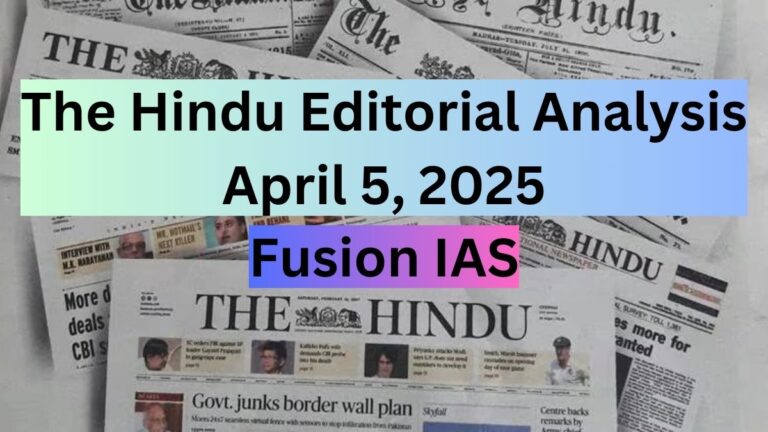
For UPSC CSE aspirants, analyzing editorials from The Indian Express is essential to build a comprehensive understanding of current affairs, policy debates, and socio-economic challenges. Here’s a structured breakdown of the editorial themes covered on January 15, 2025, tailored for UPSC preparation:
1. In Pakistan’s corridors of power, a question: To engage or not with Kabul?
- Engagement with the Afghan Taliban: Pakistan’s political and military leadership is debating whether to engage with the Afghan Taliban, despite concerns about the Taliban allowing Tehrik-i-Taliban Pakistan (TTP) to operate on Afghan soil. Political parties, including the military leadership, see engagement as necessary for Pakistan’s internal stability and regional peace, particularly to prevent Afghanistan from becoming isolated and vulnerable to influence from unfriendly states.
- Fight Against Terrorism: The Pakistani military, under General Syed Asim Munir, is working to combat terrorism, particularly in the Khyber Pakhtunkhwa region. The military and political leadership in the region are collaborating to secure the backing of local authorities and civilians in this fight.
- Challenges in Girls’ Education: Prime Minister Shehbaz Sharif hosted the ‘International Conference on Girls’ Education in Muslim Communities’ to address the barriers to girls’ education in Pakistan. The country faces severe challenges, including a low female literacy rate (49%) and a high number of children out of school (22.8 million). Critics point to the lack of substantial progress in gender parity in education, despite repeated commitments by the government.
- World Bank Support: The World Bank has pledged $20 billion for Pakistan’s long-term development. This funding will focus on critical areas such as clean water, sanitation, education, and health. The goal is to help the country address basic challenges and create sustainable growth. Given Pakistan’s economic struggles, exacerbated by austerity measures under its IMF agreement, this investment is seen as crucial.
- Potential Impact of World Bank’s Investment: If the investment is effectively utilized, it could significantly benefit Pakistan by addressing climate change risks, providing renewable energy, and improving public services like health and education, benefiting millions of people across the country.
2. SpaDex is only the first step in the next stage of India’s space ambitions
- Technological Achievement: SpaDex successfully demonstrated space docking technology by connecting two small satellites in orbit. Despite several challenges, including smaller spacecraft and limited propellant, ISRO’s team achieved this feat on the fourth attempt. India is now the fourth country to achieve this after the US, Russia, and China.
- Future Missions: The success of SpaDex lays the groundwork for upcoming missions, notably Chandrayaan-4, which will involve a sample return from the Moon. The docking technology tested in SpaDex will be crucial for future lunar missions and for the Bharatiya Antariksh Station (BAS). In particular, SpaDex acts as a cost-effective precursor to the docking systems required for missions like Chandrayaan-4.
- Operational Benefits: The mission demonstrated not only docking but also power transfer between the satellites. This technology can potentially extend the life of orbiting satellites. The mission also provided valuable data, such as radiation measurements that will assist in India’s upcoming Gaganyaan manned mission.
- Private Sector Involvement: This mission is also a milestone in fostering a new space ecosystem in India, as the satellites were assembled by a private entity in Bangalore. This reflects the increasing role of private players in India’s space sector.
- Cost-Effectiveness and Innovation: With a budget of approximately Rs 225 crore, SpaDex was far more cost-effective than similar missions by other space agencies. ISRO’s commitment to frugal engineering and cost-effective innovation has set a strong foundation for India’s growing space capabilities.
- Looking Ahead: The growth of the private space industry in India, with startups developing small satellite launch vehicles like SSLV, Agnikul, and Skyroot, will further fuel innovation and competition in the space sector. The creation of new space parks and facilities will support the growing demand for space infrastructure, both domestically and internationally.
In conclusion, SpaDex is a key milestone in India’s space journey, showcasing ISRO’s resilience, innovation, and strategic planning for future space missions, including manned missions and the development of a space station. The success of this mission not only strengthens India’s position in the global space arena but also inspires future generations of innovators.
Disclaimer:
This analysis is based on the editorial content published in Indian Express and is intended solely for informational and educational purposes. The views, opinions, and interpretations expressed herein are those of the author of original article. Readers are encouraged to refer to the original article for complete context and to exercise their own judgment while interpreting the analysis. The analysis does not constitute professional advice or endorsement of any political, economic, or social perspective.
Follow Fusion IAS


